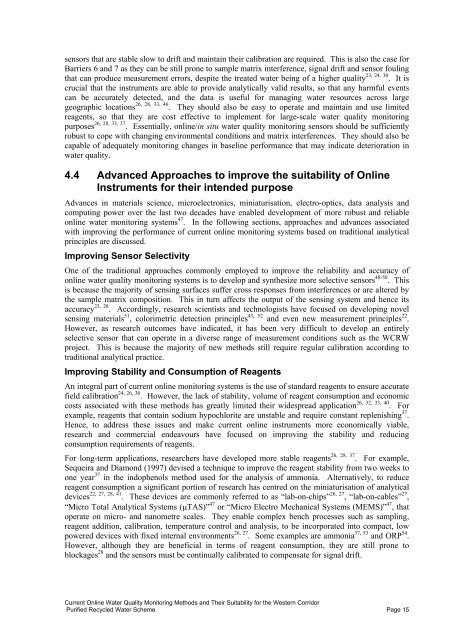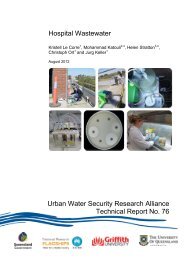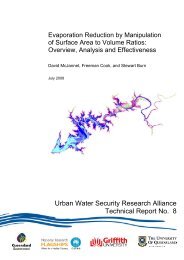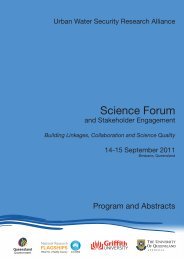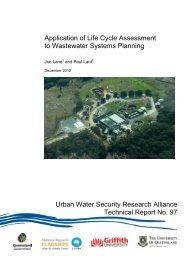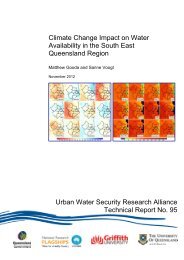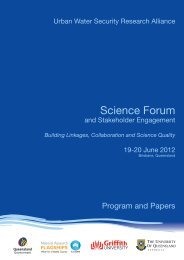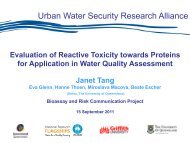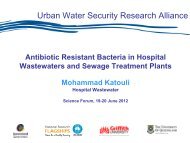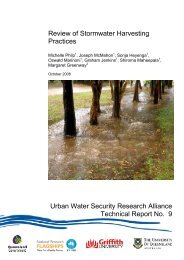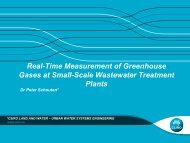Current online water quality monitoring methods and their suitability ...
Current online water quality monitoring methods and their suitability ...
Current online water quality monitoring methods and their suitability ...
Create successful ePaper yourself
Turn your PDF publications into a flip-book with our unique Google optimized e-Paper software.
sensors that are stable slow to drift <strong>and</strong> maintain <strong>their</strong> calibration are required. This is also the case forBarriers 6 <strong>and</strong> 7 as they can be still prone to sample matrix interference, signal drift <strong>and</strong> sensor foulingthat can produce measurement errors, despite the treated <strong>water</strong> being of a higher <strong>quality</strong> 23, 24, 30 . It iscrucial that the instruments are able to provide analytically valid results, so that any harmful eventscan be accurately detected, <strong>and</strong> the data is useful for managing <strong>water</strong> resources across largegeographic locations 26, 28, 33, 46 . They should also be easy to operate <strong>and</strong> maintain <strong>and</strong> use limitedreagents, so that they are cost effective to implement for large-scale <strong>water</strong> <strong>quality</strong> <strong>monitoring</strong>purposes 26, 28, 33, 37 . Essentially, <strong>online</strong>/in situ <strong>water</strong> <strong>quality</strong> <strong>monitoring</strong> sensors should be sufficientlyrobust to cope with changing environmental conditions <strong>and</strong> matrix interferences. They should also becapable of adequately <strong>monitoring</strong> changes in baseline performance that may indicate deterioration in<strong>water</strong> <strong>quality</strong>.4.4 Advanced Approaches to improve the <strong>suitability</strong> of OnlineInstruments for <strong>their</strong> intended purposeAdvances in materials science, microelectronics, miniaturisation, electro-optics, data analysis <strong>and</strong>computing power over the last two decades have enabled development of more robust <strong>and</strong> reliable<strong>online</strong> <strong>water</strong> <strong>monitoring</strong> systems 47 . In the following sections, approaches <strong>and</strong> advances associatedwith improving the performance of current <strong>online</strong> <strong>monitoring</strong> systems based on traditional analyticalprinciples are discussed.Improving Sensor SelectivityOne of the traditional approaches commonly employed to improve the reliability <strong>and</strong> accuracy of<strong>online</strong> <strong>water</strong> <strong>quality</strong> <strong>monitoring</strong> systems is to develop <strong>and</strong> synthesize more selective sensors 48-50 . Thisis because the majority of sensing surfaces suffer cross responses from interferences or are altered bythe sample matrix composition. This in turn affects the output of the sensing system <strong>and</strong> hence itsaccuracy 23, 28 . Accordingly, research scientists <strong>and</strong> technologists have focused on developing novelsensing materials 51 , colorimetric detection principles 43, 52 <strong>and</strong> even new measurement principles 22 .However, as research outcomes have indicated, it has been very difficult to develop an entirelyselective sensor that can operate in a diverse range of measurement conditions such as the WCRWproject. This is because the majority of new <strong>methods</strong> still require regular calibration according totraditional analytical practice.Improving Stability <strong>and</strong> Consumption of ReagentsAn integral part of current <strong>online</strong> <strong>monitoring</strong> systems is the use of st<strong>and</strong>ard reagents to ensure accuratefield calibration 24, 26, 36 . However, the lack of stability, volume of reagent consumption <strong>and</strong> economiccosts associated with these <strong>methods</strong> has greatly limited <strong>their</strong> widespread application 26, 32, 33, 40 . Forexample, reagents that contain sodium hypochlorite are unstable <strong>and</strong> require constant replenishing 37 .Hence, to address these issues <strong>and</strong> make current <strong>online</strong> instruments more economically viable,research <strong>and</strong> commercial endeavours have focused on improving the stability <strong>and</strong> reducingconsumption requirements of reagents.For long-term applications, researchers have developed more stable reagents 26, 28, 37 . For example,Sequeira <strong>and</strong> Diamond (1997) devised a technique to improve the reagent stability from two weeks toone year 37 in the indophenols method used for the analysis of ammonia. Alternatively, to reducereagent consumption a significant portion of research has centred on the miniaturisation of analyticaldevices 22, 27, 28, 41 . These devices are commonly referred to as “lab-on-chips” 26, 27 , “lab-on-cables” 27 ,“Micro Total Analytical Systems (TAS)” 47 or “Micro Electro Mechanical Systems (MEMS)” 47 , thatoperate on micro- <strong>and</strong> nanometre scales. They enable complex bench processes such as sampling,reagent addition, calibration, temperature control <strong>and</strong> analysis, to be incorporated into compact, lowpowered devices with fixed internal environments 26, 27 . Some examples are ammonia 37, 53 <strong>and</strong> ORP 54 .However, although they are beneficial in terms of reagent consumption, they are still prone toblockages 28 <strong>and</strong> the sensors must be continually calibrated to compensate for signal drift.<strong>Current</strong> Online Water Quality Monitoring Methods <strong>and</strong> Their Suitability for the Western CorridorPurified Recycled Water Scheme Page 15


